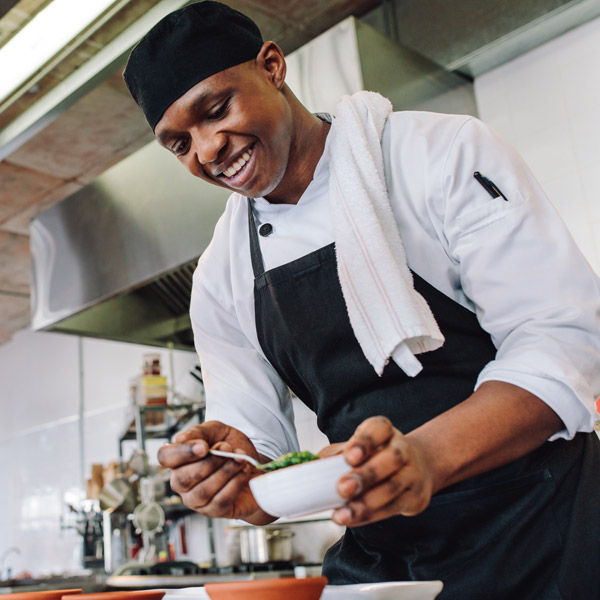Celebrity Chefs
How Do You Advance as a Chef?

A commercial kitchen features busy staff working to prepare a wide variety of foods to high standards of taste and food safety. To maintain order and make sure everything gets done, many kitchens organize their chefs into a hierarchy, but the chef levels can look different depending on the kitchen. With several names for each position and additional positions in larger kitchens, it’s helpful to understand who does what or which route you could take to advance. In this article, we answer common questions about the different chef roles and describe how to work toward a higher level.
What are the chef levels?
Modern kitchens organize their staff using the kitchen brigade system, which has a historic background in Europe. Today’s foodservice settings have prompted changes and additions, but the main levels remain. Here are some positions in the kitchen brigade system:
Group chef
Also called the executive chef, the group chef is an executive position in larger restaurant groups who manages all kitchens and does little food preparation. In smaller restaurants, the executive chef title refers to the chef de cuisine.
Chef de cuisine
Also called the head chef or executive chef, the chef de cuisine manages menus, suppliers, costs and kitchen staff. In larger restaurants, this position involves little food preparation.
Sous chef
Also called the second chef, the sous chef reports to the chef de cuisine and supervises the chefs de partie, filling in for them if needed. This position may not exist in small kitchens, and larger kitchens may have several sous chefs with senior or junior designations.
Senior chef
This is a position in larger kitchens that manages the preparation of certain menus.
Chef de partie
Also called a station chef or line chef, a chef de partie manages a station in the kitchen. There are ten types of chef de partie:
-
Saucier, the saute chef
-
Poissonnier, the fish chef
-
Rotisseur, the roast chef
-
Grillardin, the grill chef
-
Friturier, the fry chef
-
Entremetier, the vegetable chef
-
Garde manger, pantry chef
-
Boucher, the butcher
-
Patissier, the pastry chef
-
Chef de tournant, the swing chef who assists or fills in at other stations
Demi chef
In larger kitchens, the ten chef de partie positions may have a demi chef to assist and fill in when the main chef de partie is away.
Commis chef
The commis chef is an assistant position, and a person in or recently graduated from culinary school usually fulfills this role. It involves work and training for one of the chef de partie stations.
Kitchen assistant
Also called the kitchen porter or kitchen hand, this position involves cleaning and basic food preparation and does not require culinary training.
Expediter
This role does not involve food preparation but refers to the person who brings the food from the kitchen to the server or the table. The sous chef or chef de cuisine can be the expediter in some kitchens and inspect the food before serving it to guests.
How many chef levels are in a kitchen?
The number of chef levels depends on the kitchen and the type of cuisine it serves. In a small establishment, there may only be two or three levels, including a head chef, two to four station chefs who take on multiple stations and some kitchen staff. In larger kitchens, there are staff for all brigade levels, and there may be junior and senior positions within the sous chef and chef de partie positions. This can translate to 14 or 15 levels within the same kitchen.
What is the difference between a chef and a cook?
A chef has completed some formal culinary training, while a cook has gained experience through work only. Depending on the venue, a restaurant may have several cooks besides the different levels of chefs, or it may only employ cooks if the cuisine is casual.
There are different types of cooks just like there are different types of chefs. In smaller establishments, one cook may be responsible for several of these tasks. Here are some of the types of cooks:
-
Prep cook: The prep cook prepares the kitchen and ingredients for the other cooks and is an introductory position where the cook learns basic commercial kitchen skills.
-
Line cook: A line cook works on a variety of dishes and may handle multiple stations at once.
-
Short-order cook: The short-order cook handles the dishes that can they can make in quick succession.
-
Fry cook: A fry cook manages the deep fryers and occasionally the grill.
How to advance to a higher chef level
While there is no single way to advance as a chef, experience and knowledge help you move forward. Here are some steps to follow to become a more advanced chef:
1. Gain technical knowledge
The first step to advancing as a chef is to do some research. Try to read as much as you can about being a chef and the different careers available and learn about different cuisines in different cities. Consider interviewing a chef who holds a position you’d like to have in order to find out what training and background led them to that position.
2. Define your goal
Decide what level you’d like to reach, whether it’s becoming a specialized chef in one area, owning your own restaurant or running a highly ranked chain of restaurants. This helps you decide the best steps to take next. More business training helps if you’d like to work as an executive chef or own a restaurant, while learning more about a specialized branch of cooking could help you become a station chef more quickly.
3. Attend culinary school
If you’re currently working as a cook or looking at education options in order to become a chef, a culinary education is the next step. This provides you with the kitchen skills you need to work as a chef in a commercial kitchen. Culinary schools often offer specializations in certain types of food preparation, so it’s good to know what your goals are before you begin any course of study. Vocational schools may also offer culinary classes.
4. Begin work experience
After culinary school, your next step might be an internship, apprenticeship or working as lower-level chef. Larger kitchens hire commis chefs, who are usually just out of culinary school, to work and gain a basic level of knowledge in the kitchen before becoming a specialized chef.
5. Gain a variety of experience
To show that you are ready to advance, pursue opportunities to display your skills and knowledge. To develop new dishes and gain new skills, try researching the cuisines of different regions and learning more about those who have worked successfully in different kitchens. As you show your supervisors that you are skilled and willing to work hard, you can stand out as a good candidate for advancement.
6. Mentor newer chefs
More advanced chefs are responsible for training others in addition to completing their own kitchen tasks. Mentoring those who are new to the kitchen develops your leadership skills, gives you training experience and shows that you take initiative. When you are in a leadership position, these skills become useful for onboarding new chefs and cooks.
7. Pursue business education
If your goal is to be a group chef for a group of restaurants or to own your own business, you need skills outside your kitchen expertise. Business education can help you gain skills for the logistical side of operations. Some culinary schools offer higher levels of education for experienced chefs, but you might also consider business classes offered by colleges or organizations close to you.

How Do You Advance as a Chef?
